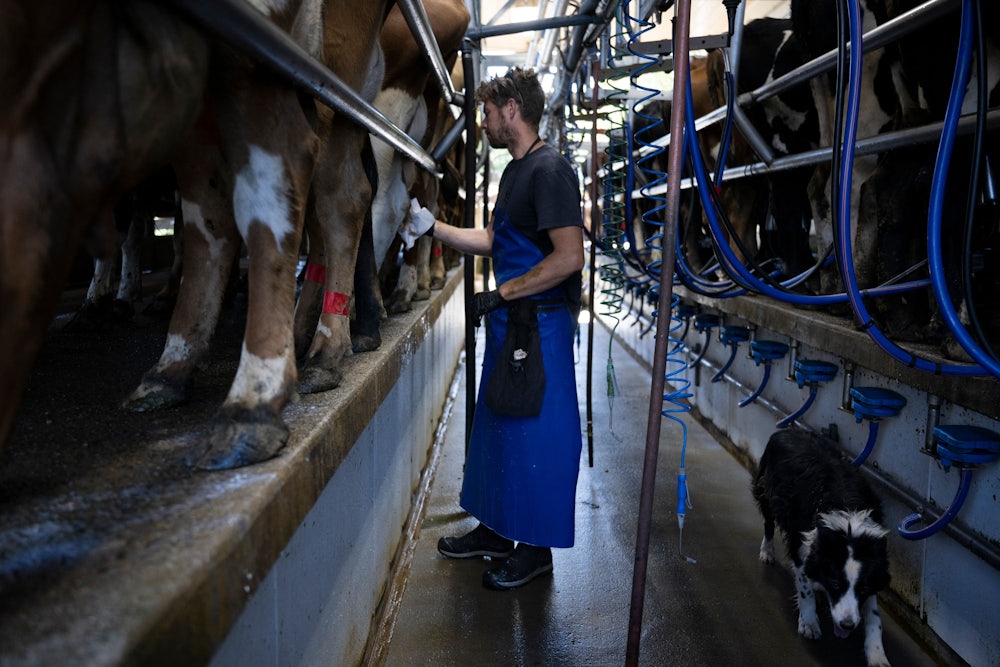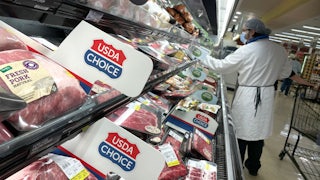In early July, a dairy farmworker in Colorado tested positive for H5N1, the current strain of avian flu that’s ripping through dairy cows. It marked the fourth human case contracted on a dairy farm; a worker tested positive in Texas in April, and then two others in Michigan. While the virus has yet to be found spreading among the general public, it’s clear that the dairy industry’s workforce is very much at risk of infection. And each time a new person gets sick, it’s a chance for the virus to mutate, allowing it to potentially spread beyond the agricultural workforce.
Yet there is effectively no federal agency with the power to mandate protections to keep more workers from getting sick. The Centers for Disease Control and Prevention has no authority to impose safety measures on farming operations unless it declares a public health emergency, which it isn’t likely to do unless the virus spreads widely. The U.S. Department of Agriculture only regulates the treatment of animals, not of workers.
The obvious federal body to tackle this problem is the Occupational Safety and Health Administration, which is responsible for preventing American workers from getting sick or hurt on the job. But OSHA can’t touch nearly all dairy farms because of their small size.
OSHA’s lack of regulatory authority on smaller farms dates to 1976, when a rider was attached to an appropriations bill in Congress that barred the agency from using federal funds to enforce regulations on farms with 10 or fewer employees. That leaves 96 percent of animal husbandry operations outside of OSHA oversight. (Poultry plants, where the virus is also infecting workers, typically have more employees and so are subject to OSHA’s regulation.)
“Historically there has been a real aversion politically to regulating farms,” said Patty Lovera, a policy adviser at the Campaign for Family Farms and the Environment, a coalition that works against factory farming.
Without a federal mandate, dairy farm owners are being asked to voluntarily institute difficult, costly measures, and many are resisting, which is what happens “when there’s not any threat of enforcement,” Lovera said. The USDA has made up to $28,000 available to farms with infected herds to cover the cost of gloves, goggles, and other protective equipment for workers, but few farms have taken the money. Texas, a state with a high number of infected herds and the first with a confirmed human case, began offering protective equipment to farm owners at the beginning of April, but a month later just four had accepted it. Idaho, which also started offering equipment in April, had zero takers by May. In Michigan, many farm owners have shown little interest in outreach from local health authorities to participate in testing and research or to use protective gear.
States that operate their own OSHA-approved workplace safety plans aren’t subject to the small-farm exemption. That includes Iowa, Michigan, and Minnesota, all of which have confirmed dairy cow cases of bird flu, as well as other major dairy states like California, New Mexico, New York, and Washington that so far have no reported cases. These states could use their own money to require protective measures for workers, but so far none appear to be doing so.
“There is much more that can be done here,” said Peg Seminario, who was the director of occupational safety and health at the AFL-CIO until she retired in 2019. She called the situation “a slow-moving train wreck that seems to be speeding up.”
Much is still unknown about the virus, including exactly how it’s spreading to humans. But a likely route is workers getting splashed by tainted milk in milking parlors, given that milk is where sick cows appear to be shedding a lot of the virus. In such a workplace, “the udder is usually at face height,” said Meghan Davis, associate professor at the Johns Hopkins Bloomberg School of Public Health. That’s why the CDC has recommended the use of goggles or face shields at farms with infected animals to protect workers’ eyes from being exposed to the virus. It’s also possible that milk is getting on the hands of workers—possibly from tainted equipment that should be cleaned more often—who then touch their eyes or mouths.
Testing also is spotty. Workers are only being tested once cows are found to be positive, and even then just a sample of workers are tested on that farm. Workers themselves are likely to be wary of seeking help if they get sick. They typically don’t get paid sick leave and have poor access to health insurance. “They worry about lost wages or, even worse, any kind of employer retaliation, including losing their jobs,” said Alexis Guild, vice president of strategy and programs at Farmworker Justice. They may not even be aware of the risks or symptoms of bird flu, she said.
But without more testing—and testing not just of people who report symptoms but of the dairy worker population in general, to catch cases where symptoms are not yet present—officials will remain in the dark about how and how quickly the virus is spreading. “More surveillance is absolutely critical,” Davis said. That means testing farms that haven’t reported positive cases, which would “help us get a real picture of the extent of the outbreak and help inform mitigation and prevention strategy,” she said.
Even if dairy workers didn’t exist in a regulatory no-man’s-land, there are other barriers to requiring protective measures. Given that it’s the summer, these workplaces are very hot and damp. In a milking chamber, goggles fog up and masks get wet. Workers are already at risk of heat-related illness in their coveralls and boots; requiring them to wear more equipment will make it worse. Guild said that workers have told her that, depending on what equipment they’re given and what training comes with it, it can slow them down, a big impediment given the constant stream of cows that have to be milked. More cleaning of equipment, meanwhile, means disrupting operations in ways that costs owners money in a low-margin industry.
Then there’s the question of enforcement. Even if OSHA had the authority over dairy farms, it is perpetually underfunded; it has so few investigators that it would take 186 years for them to inspect all of the workplaces the agency oversees. The agricultural workforce is also largely made up of immigrants, some of whom may not have legal status. As such, they are likely to be wary of interacting with government officials or reporting problems. Even dairy workers with secure legal status typically rely on their employers for housing and spend most of their time isolated on the farms, making it difficult to speak out about an employer that isn’t following the rules.
The farm owners, meanwhile, have good reason to resist testing for the virus, fearing that they would lose money if it’s discovered that their milk is tainted. The USDA has offered incentives to compensate farmers for the cost of disposing of tainted milk, but those funds are not likely to match what they would have gotten from selling that milk at market value.
So far, the workers who have tested positive have had mild symptoms, mostly conjunctivitis and respiratory issues. But the potential for symptoms to become more severe lingers, particularly if it keeps spreading unabated. “We’re going to have more workers become ill,” Davis predicted. The virus is already cropping up in poultry workers in Colorado.
For now, the risk to the greater public, other than for those who consume unpasteurized milk, remains low. That could change if the symptoms of those who get infected become more severe or if the virus starts to jump from person to person—which could already be happening without our knowledge. In June, a USDA survey conducted in Michigan found that shared worker housing was a potential transmission pathway. Making sure the virus doesn’t just keep spreading among workers is “now the front line of protecting everybody else,” Seminario said.
This story was produced in collaboration with the Food & Environment Reporting Network, a nonprofit news organization.






